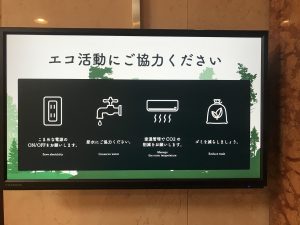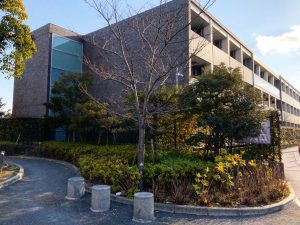Environmental Initiatives
Our Approach to Climate Change
The world has been accelerating the transition to a carbon-neutral society. This trend is found in the global long-term goal set in the Paris Agreement, an international framework since 2020 to address global warming. The goal in the agreement is to hold the increase in the global average temperature to well below 2°C above pre-industrial levels and pursue efforts to limit the temperature increase to 1.5°C above pre-industrial levels, and Japan has declared its intention to achieve carbon neutrality by 2050.
The Investment Corporation and the Asset Manager view climate change as an important issue that changes the natural environment and social structures dramatically and has a significant impact on real estate management. Contribution to the achievement of a carbon-neutral society is considered as a social mission.
In accordance with the TCFD recommendations, we will identify and analyze risks and opportunities related to climate change and proceed with step-by-step disclosure of information related to climate change. We will continuously work to reduce the environmental impact of business activities as we understand social needs and expectations for us through active dialogue with external stakeholders.
Support for TCFD Recommendations
The Task Force on Climate-related Financial Disclosures (TCFD) is an international initiative established by the Financial Stability Board (FSB), at the request of the G20. The purpose of the TCFD is to discuss disclosure of climate-related financial information and the responses by financial institutions. The TCFD Consortium is a group of companies, financial institutions, and other organizations that support the TCFD recommendations. The consortium was established with a view to further discussing effective corporate disclosure of climate-related information and initiatives to link disclosed information to appropriate investment decisions on the part of financial institutions and other organizations.
To clarify the policy and system for addressing climate-related issues and expand the disclosure of information about relevant initiatives, the Asset Manager established the Climate Change and Resilience Policy and announced its support for the TCFD recommendations in December 2021. In January 2022, the Asset Manager joined the TCFD Consortium, a group of domestic companies that support the TCFD recommendations.
Click here for TCFD.
Click here for TCFD Consortium.
 |
 |
Governance Related to Climate Change
The Asset Manager has established the Climate Change and Resilience Policy, the policy for responding to risks and opportunities related to climate change and working to make business and strategy resilient to climate-related issues.
In accordance with the policy, Chief Climate-Related Issues Officers (general managers of departments engaged in sustainability promotion) make regular reports to the Chief Executive Officer for Climate-Related Issues (President and Representative Director) at Sustainability Promotion Committee meetings. The reports cover matters related to responses to climate change, including identification and evaluation of impacts of climate change, management of risks and opportunities, progress of initiatives for adaptation and mitigation, and indicator and target setting. The Sustainability Promotion Committee deliberates and discusses issues related to climate change, after which the Chief Executive Officer for Climate-Related Issues makes final decisions. Under this system, climate-related issues are supervised by the President and Representative Director.
Policy Regarding Sustainability and Sustainability Promotion System
Strategy
To factor climate-related risks and opportunities into the Investment Corporation’s real estate management business, the Asset Manager conducted a scenario analysis of the Investment Corporation’s portfolio. The Asset Manager referred to climate outlooks published by international organizations and other entities, in order to identify risks and opportunities of climate change brought to the Investment Corporation and assess financial impacts on the Investment Corporation's business. Using a 1.5°C/2°C scenario and a 4°C scenario, a qualitative analysis was conducted as described below.
Target of Analysis and Prerequisites
Target: All properties owned by the Investment Corporation
Scope: Overall real estate investment and management business
Target period: From 2023 to 2050, with short-term, medium-term, and long-term timeframes
(Short term: 2023–2025, Medium term: 2026–2030, Long term: 2031–2050)
Analysis Procedure
①In accordance with the TCFD framework, the Asset Manager discussed climate-related risks and opportunities and identified factors that may have a significant impact on the Investment Corporation’s business domain.
②Concerning the risks and opportunities identified in (1), the Asset Manager summarized and grasped what the world would look like under the 1.5°C/2°C and 4°C scenarios, based on the parameters (forecasts) of the adopted scenarios.
③Based on the forecasts in (2), the Asset Manager conducted a qualitative analysis for the Investment Corporation, calculated financial impacts in the scenario analysis, and worked out countermeasures.
Key Scenarios Adopted in the Analysis
| 1.5/2℃ scenario | 4℃ scenario | |
|---|---|---|
| Transition Risks | IEA World Energy Outlook2024 NZE |
IEA World Energy Outlook2024 STEPS |
| Physical Risks | IPCC Fifth Assessment Report RCP4.5 | IPCC Fifth Assessment Report RCP8.5 |
Expected Future in Each Scenario
4°C Scenario
The 4°C scenario forecasts a future where greenhouse gas emissions are on an increasing trend due to insufficient climate change mitigation, without new regulations, taxation, or other measures to achieve a carbon-neutral society. The scenario involves high relative physical risks from climate disasters and low transition risks.
| Government | Tenants | Investors | Financial Institutions | Climate/Weather |
|---|---|---|---|---|
Stricter legal regulations related to resilience |
Increased needs for measures against storm and flood damage, heatstroke, etc. |
Higher importance of physical risk assessment in making investment decisions |
Increased needs for physical risk assessment in making lending decisions |
Severer storm and flood damage and increased natural disasters due to rising temperatures, etc. |
1.5℃/2℃ Scenario
The 1.5°C/2°C scenario forecasts a future where greenhouse gas emissions are on a decreasing trend, with the advancement of social policy, emission regulations, technology investment, and other measures to achieve a carbon-neutral society. The scenario involves low relative physical risks from climate disasters and high transition risks.
| Government | Tenants | Investors | Financial Institutions | Climate/Weather |
|---|---|---|---|---|
Stricter regulations against GHG emissions due to an introduction of carbon tax |
Increased needs for environmental performance |
Increased needs for the assessment of compliance with environmental regulations and environmental certifications in making investment decisions |
Increased needs for the assessment of compliance with environmental regulations and environmental certifications in making lending decisions |
A certain degree of advancement of chronic climate change, such as increased storm and flood damage |
Financial Impacts in the Scenario Analysis
For each scenario, the Asset Manager classified the financial impacts of identified risks and opportunities into short-term, medium-term and long-term impacts and examined relative scales of impacts on the Investment Corporation. Shown below are medium-term and long-term risks from climate change that have a certain degree of financial impacts.
1.Transition risks: Policy and legal risks, technology risk, market risk, and reputation risk
2.Acute physical risks: Event-driven climate risks, including typhoons and floods
3.Chronic physical risks: Climate risks caused by long-term shifts in climate patterns, including sustained higher temperatures and sea level rise
※GHG refers to Green House Gas.
Risk Management
The Investment Corporation’s Climate Change and Resilience Policy sets out processes to identify, assess, and manage the impacts of climate change risks and opportunities on the corporation’s management activities, strategies, financial plans, etc.
● Chief Climate-Related Issues Officers summarize climate-related risks and opportunities and report the progress to the Sustainability Promotion Committee, in principle, once a year.
● The Sustainability Promotion Committee continuously identifies, assesses, and manages climate change risks and opportunities that are important to the business and financial plans and affect the asset management operations of the Investment Corporation. Based on the above reports, the committee prioritizes issues of strategic importance to the business.
● The Chief Executive Officer for Climate-Related Issues instructs to factor important climate-related risks with high priority, which have been deliberated by the Sustainability Promotion Committee, into the existing company-wide risk management program. The risk identification, assessment, and management processes are thus integrated.
Indicators and Targets
The Investment Corporation views the transition to a decarbonized society as an opportunity and has established the following as key monitoring indicators (KPI) in the process of managing climate change risks and opportunities.
Improvement of Environmental Performance
| Target (KPI) | |
|---|---|
| Reduction of CO2 emissions | Mid-term target (FY2030) : Reduction of 20% in CO2 emissions on an intensity basis across the portfolio by FY2030 (compared with FY2022) |
| Long-term target (FY2050) : Achieved carbon neutrality in CO2 emissions on an intensity basis across the portfolio by FY 2050 |
|
| Percentage of environmental certifications acquired | Mid-term target (FY2030) : Achieve an environmental certification ratio of at least 30% for the entire portfolio |
Environmental Targets and Performance
The Investment Corporation is striving to improve environmental performance by establishing environmental targets for the reduction of energy consumption, CO2 emissions, and water consumption across the entire portfolio and monitoring its performance with respect to achieving them.
Environmental Targets
Rental housing / Healthcare
| Item | target | |
|---|---|---|
| Energy | Consumption intensity |
8% reduction by FY2030 (compared to FY2022) |
| CO2 | 20% reduction by FY2030 (compared to FY2022) | |
| Water | Maintainance of the status quo | |
Performance
In conjunction with the medium- to long-term targets formulated for its ESG initiatives, the Investment Corporation is working to keep track of energy consumption, CO2 emissions, water consumption.
The reduction targets and actual results of energy consumption, CO2 emission and water consumption for the residence (common area and part of the exclusive area) are as follows.
Rental housing
| Item | Unit | Actual reduction | |||
|---|---|---|---|---|---|
| FY2022 【base year】 |
FY2023 | FY2024 | Rate of change | ||
| Energy | Consumption (MWh) | 8,687 | 8,420 | 8,666 | -0.24% |
| Consumption intensity (MWh/m²) | 0.172 | 0.155 | 0.160 | -6.88% | |
| CO2 | Emission (t-CO2) | 3,611 | 3,547 | 3,670 | 1.63% |
| Emission intensity (t-CO2/m²) | 0.045 | 0.044 | 0.043 | -5.28% | |
| Water | Consumption (m³) | 194,337 | 165,663 | 170,658 | -12.19% |
| Consumption intensity (m³/m²) | 1.57 | 1.38 | 1.27 | -18.92% | |
*2 Properties that were bought and sold in each target fiscal year are excluded from the calculations for that year.
*3 CO2 emissions are calculated by the asset management company based on adjusted emission factors for each electric power supplier published by the Ministry of the Environment.
*4 Sompo Risk Management Inc. is conducting third-party verification of each environmental performance data (energy consumption, water consumption) for rental housing properties from fiscal 2023 onwards.
Healthcare
| Item | Unit | Actual reduction | |||
|---|---|---|---|---|---|
| FY2022 【base year】 |
FY2023 | FY2024 | Rate of change |
||
| Energy | Consumption (MWh) | 48,780 | 50,836 | 48,196 | -1.20% |
| Consumption intensity (MWh/m²) | 0.232 | 0.237 | 0.218 | -6.26% | |
| CO2 | Emission (t-CO2) | 17,372 | 17,078 | 18,642 | 7.31% |
| Emission intensity (t-CO2/m²) | 0.081 | 0.076 | 0.082 | 1.34% | |
| Water | Consumption (m³) | 487,258 | 497,571 | 513,815 | 5.45% |
| Consumption intensity (m³/m²) | 2.26 | 2.27 | 2.27 | 0.54% | |
*2 Properties that were bought and sold in each target fiscal year are excluded from the calculations for that year.
*3 CO2 emissions are calculated by the asset management company based on adjusted emission factors for each electric power supplier published by the Ministry of the Environment.
*4 Each environmental performance data for fiscal 2023 (energy consumption, water consumption) has undergone third-party verification by Sompo Risk Management Inc.
Construction of Environmental Management System
In order to pursue energy-saving, CO2 emissions reduction, and efficient use of water resources, the Investment Corporation has established an environmental management system. Focusing on energy consumption, CO2 emissions, and water usage, it sets targets, tracks performance, manages budgets, and executes countermeasures (PDCA cycle), contributing to the realization of a sustainable society through the reduction of its environmental footprint.
Implementing Eco-Friendly Initiatives via Real Estate Investment
Efforts for environmental consideration
Introduction and renovation of LED lighting
For environmental conservation, the Investment Corporation has been switching to LED lights in the common areas of properties.
This will help reduce power consumption and environmental impact.
(TK Flats Shibuya)
| Efforts | Sep 2023 | Mar 2024 | Sep 2024 | Mar 2025 |
| LED lighting | 614 units | 453 units | 789 units | 421 units |
Posting a call for power saving / water saving
Posting digital signage to encourage tenants of rental housing residents to save electricity and water.
(Prospect Glarsa Hiroo)
Installation and renovation of environment-friendly equipment
For environmental conservation, the Investment Corporation has been installation and renovation of environment-friendly equipment in the exclusive areas of properties.
| Efforts | Sep 2023 | Mar 2024 | Sep 2024 | Mar 2025 |
| energy-saving air conditioners | 627 units | 323 units | 500 units | 295 units |
| water-saving showers | 116 units | 121 units | 151 units | 135 units |
| water-saving toilets | 36 units | 25 units | 40 units | 34 units |
 |
 |
 |
| (TK Flats Shibuya) | (Gala Place Shinjuku Gyoen) | (Joy Oyamadai) |
Installation of Delivery Box
A delivery box is installed in the rental housing owned by the Investment Corporation.
Since this initiative will not only improve the convenience of tenants of rental housing, but will also lead to reduction of redelivery rate and CO2 reduction. the Investment Corporation promotes the installation of the delivery box.
(Gran Casa Omori-Kaigan)
The ratio of installation of delivery boc in rental housing (based on the number of buildings)
| Efforts | Sep 2023 | Mar 2024 | Sep 2024 | Mar 2025 |
| Installation of delivery box | 87.9% | 89.3% | 90.3% | 92.8% |
- ※13buildings such as a single-tenant property and compartmentalized ownership property are excluded.
Greening of premises and promotion of biodiversity
We are working to conserve biodiversity by establishing self-managed parks and managing plantations aimed at improving the quality of biodiversity at a property owned by the Investment Corporation..
(Gran Casa Ryokuchi-koen)
Environmental Pollution Countermeasures
When acquiring new properties, the Investment Corporation strives to avoid risks by checking in advance for environmental and social risks to ensure there are no problems, including hazardous substances (PCB, asbestos, etc.) and soil contamination, in addition to conducting site inspections and surveys. If hazardous substances or the like are present at a property that it owns, it will implement appropriate countermeasures, management, and disposal in compliance with the laws and regulations.
Eco-Friendly Initiatives with Stakeholders
Supply Chain Management
In order to promote environmental and social initiatives in its supply chain, the Investment Corporation has established a Sustainable Procurement Policy. When selecting new property management companies, suppliers, etc. or evaluating existing counterparties, the status of their sustainability-related initiatives is included in the criteria, along with their facilities management services, lease operation and management services, leasing services, etc., and they are required to understand and cooperate with the Investment Corporation's environmental and social initiatives.
Promoting Green Leasing
As of March 31, 2025, DLI had green lease agreements in 62.8% of its entire portfolio (based on total floor area). In its rental housing, DLI has added sustainability clauses to lease agreements for new contracts since FY2017, and is working with tenants to reduce electricity, gas, and water consumption and promote recycling.
Conclusion of green lease agreements
In FY2024, this investment corporation newly concluded green lease agreements with five healthcare facility operators. In conducting facility operations with consideration for sustainability, they are working collaboratively to reduce environmental impacts such as energy conservation in real estate and to maintain and improve tenant comfort.
Implementation of sustainability training
In FY2024, this investment corporation conducted sustainability training for all 17 healthcare facility operators.
Distribution of Sustainability Guides
Each Investment corporation has been distributing and posting the Sustainability Guide to tenants and residents of the properties they own since 2023. The guide includes the Asset Manager's sustainability policy and examples of specific sustainability initiatives that can be easily put into practice, and is used to raise awareness of the need to combat global warming and achieve the SDGs.
